|
|
General: FRANKLIN DELANO ROOSEVELT FREEMASON MADELEINE HOLY GRAIL DAY D PENTAGON DOLLAR
Scegli un’altra bacheca |
|
Rispondi |
Messaggio 1 di 56 di questo argomento |
|
|
|
|
|
Rispondi |
Messaggio 42 di 56 di questo argomento |
|
First, NYC/Long Island can be associated with 'knowledge' through the symbolisms of 'apple' ("Big Apple"), 'rose' (state flower), 'fire' (Statue of Liberty, its connection to Paris/'torch'), etc. and as we've seen in foregoing sections it's part of the 'ark' complex via VI-97. Furthermore from the 'apple' connection follows the notion of the 'serpent'. Now, all those 'knowledge'/Sirius connections of NYC can be transferred to Mars because, as illustrated in 'Babylon Matrix', NYC is also related to Mars, especially the Cydonia region with all the potentially artificial structures. Mars being red and circular is associatable with the 'apple', the red and round 'Big Apple' (NYC). Now, some might argue that the fruit Eve ate was not necessarily an 'apple', but we generally thought of it as an apple today and that has to count in symbolism. But there is a much more precise connection - the latitudes of NYC and Cydonia are exactly the same, 40.5~41N.
The events closely associated earlier with X-72 and more or less with the ark, the two random shootings in a library and school ('Resonance' #7 and 8), appear to back up the Mars-Sirius connection also. Those two similar events, only five days apart, occurred one on the Cydonian latitude and the other on the Sirius 'angle' latitude. The Mormon library shooting took place at ~40.5N, and the Colorado school shooting at ~39.5N. The name 'Salt Lake City', where the library shooting occurred, may be relevant also since mythologically the 'salt water' is of female - and Sirius is filled with female associations ('goddess', 'star of Women', etc.).
Moreover, Temple mentions in his book that "when making rhetorical allusion to the Dog Days, the Latins would often speak of Sirius being red at the time..." Now, this is quite significant for not only is Sirius described as 'red' like Mars, but the "Dog Days" would refer to a period in or around July - the exact time-frame indicated by Quatrain X-72.
The Sirius-correlated Argo also turns out to be very relevant here. Because the main mission of Jason, the leader of the Argonauts who has been identified as the "appeasing King"/"King of terror" of X-72 earlier, was to obtain the 'golden fleece', and in Temple's words, "Aries was definitely identified with the golden fleece". In case you don't know, Aries is the Greek Mars. Aries is also a sign of the zodiac, "ruled" by Mars, and it is classified as a 'fire sign' - correlating with the fire-knowledge symbolism. I should also point out that Mars is called 'fire star' in Japanese.
Moreover, Sirius/Isis' son Horus provides intriguing correlations. First, the Great Sphinx associated earlier with 'ark' was called by Egyptians "Horus of Horizon" which also happens to be a name given to Mars. And the word 'Cairo', where the Sphinx is (actually slightly west of Cairo), is derived from 'Mars'. Mars was also called 'Horus the Red'. And the word 'Heru' (Egyptian name for Horus) also has the meaning of 'face' - seemingly a reference to the infamous 'Face on Mars' at Cydonia! (So, as you can see, the Mars-Horus connection is quite obvious.) Next, Sirius/ark comes into the web of associations, as the Argo also relates to Horus (thus to Mars too) as the Greek derivation of Horus, 'Circe', plays a prominent role in the story of Argo. Also, as Temple hypothesizes, the names of the original captain of Argo, Herakles, and his protectress Hera may be derived from 'Heru' - the Egyptian name for Horus. Furthermore, we're told that Herakles/Hera is related to the word 'Seirios' from which we have the word 'Sirius' - strengthening the Mars-ark-Sirius connection. But as if it wasn't enough, Temple goes on to point out that 'Seirios' also has the meaning of 'fiery/scorching', that can easily be a reference to Mars.

And finally, Mars and Sirius are linked by the 'tetrahedral angle' of 19.5 degrees. '19.5 degrees' is one of the most significant notions derived from the supposed artificial structures of Cydonia that suggests their artificiality, according to investigators like Richard Hoagland ('The Monuments of Mars'). It is viewed as a definite 'signal in the noise' - some kind of a 'message' left there by some intelligence. This number, '19.5', is called t, the 'tetrahedral constant', because of  its significance in tetrahedral geometry (a tetrahedron is a pyramid shape composed of four equilateral triangular sides): the apexes of a tetrahedron when placed within a circumscribing sphere, one of the tetrahedron's apexes touching the south (or north) pole, the other three apexes touch the surface of the sphere at 19.5 degrees north latitude. So it is interesting that the Egyptian symbol for Sirius is a triangle which can be viewed as a 2-dimensional representation of a tetrahedron. its significance in tetrahedral geometry (a tetrahedron is a pyramid shape composed of four equilateral triangular sides): the apexes of a tetrahedron when placed within a circumscribing sphere, one of the tetrahedron's apexes touching the south (or north) pole, the other three apexes touch the surface of the sphere at 19.5 degrees north latitude. So it is interesting that the Egyptian symbol for Sirius is a triangle which can be viewed as a 2-dimensional representation of a tetrahedron.
https://www.goroadachi.com/etemenanki/1999-sirius.htm |
|
|
|
Rispondi |
Messaggio 43 di 56 di questo argomento |
|
The lost history of the Freemasons
Amanda Ruggeri
Features correspondent
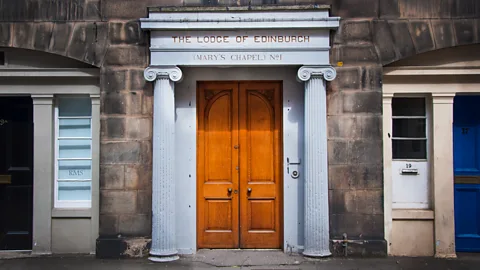 Amanda Ruggeri Amanda Ruggeri
Mary’s Chapel may only be open to fellow Freemasons, but its location is anything but a secret (Credit: Amanda Ruggeri)
Conspiracy theories abound about the Freemasons. But Scotland’s true Masonic history, while forgotten by many for centuries, remains hidden in plain sight.
With its cobblestone paving and Georgian façades, tranquil Hill Street is a haven in Edinburgh’s busy New Town. Compared to the Scottish capital’s looming castle or eerie closes, it doesn’t seem like a street with a secret.
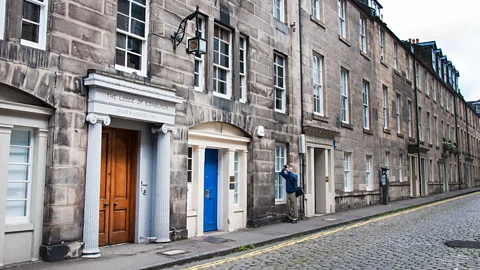 Amanda Ruggeri Amanda Ruggeri
Tranquil and historic, Edinburgh’s Hill Street attracts few tourists (Credit: Amanda Ruggeri)
Walk slowly, though, and you might notice something odd. Written in gold gilt above a door framed by two baby-blue columns are the words, “The Lodge of Edinburgh (Mary’s Chapel) No 1”. Further up the wall, carved into the sandstone, is a six-pointed star detailed with what seem – at least to non-initiates – like strange symbols and numbers.
Located at number 19 Hill Street, Mary’s Chapel isn’t a place of worship. It’s a Masonic lodge. And, with its records dating back to 1599, it’s the oldest proven Masonic lodge still in existence anywhere in the world.
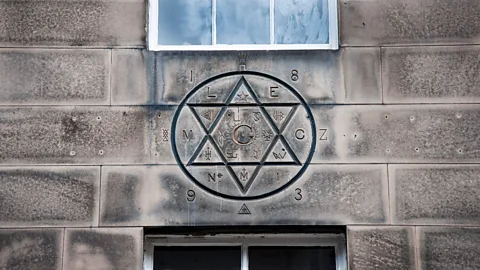 Amanda Ruggeri Amanda Ruggeri
At 19 Hill Street, look up to see this six-pointed star, a Masonic symbol (Credit: Amanda Ruggeri)
That might come as a surprise to some people. Ask most enthusiasts when modern Freemasonry began, and they’d point to a much later date: 1717, the year of the foundation of what would become known as the Grand Lodge of England. But in many ways, Freemasonry as we know it today is as Scottish as haggis or Harris tweed.
From the Middle Ages, associations of stonemasons existed in both England and Scotland. It was in Scotland, though, that the first evidence appears of associations – or lodges – being regularly used. By the late 1500s, there were at least 13 established lodges across Scotland, from Edinburgh to Perth. But it wasn’t until the turn of the 16th Century that those medieval guilds gained an institutional structure – the point which many consider to be the birth of modern Freemasonry.
Take, for example, the earliest meeting records, usually considered to be the best evidence of a lodge having any real organisation. The oldest minutes in the world, which date to January 1599, is from Lodge Aitchison’s Haven in East Lothian, Scotland, which closed in 1852. Just six months later, in July 1599, the lodge of Mary’s Chapel in Edinburgh started to keep minutes, too. As far as we can tell, there are no administrative records from England dating from this time.
“This is, really, when things begin,” said Robert Cooper, curator of the Grand Lodge of Scotland and author of the book Cracking the Freemason’s Code. “[Lodges] were a fixed feature of the country. And what is more, we now know it was a national network. So Edinburgh began it, if you like.”
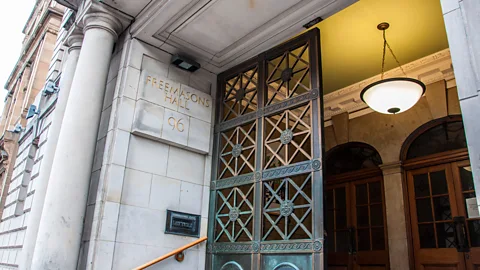 Amanda Ruggeri Amanda Ruggeri
The Grand Lodge of Scotland, also known as Freemasons Hall, stands in the heart of Edinburgh’s New Town (Credit: Amanda Ruggeri)
I met Cooper in his office: a wood-panelled, book-stuffed room in the Grand Lodge of Scotland at 96 George Street, Edinburgh – just around the corner from Mary’s Chapel. Here and there were cardboard boxes, the kind you’d use for a move, each heaped full with dusty books and records. Since its founding in 1736, this lodge has received the records and minutes of every other official Scottish Masonic lodge in existence. It is also meant to have received every record of membership, possibly upwards of four million names in total.
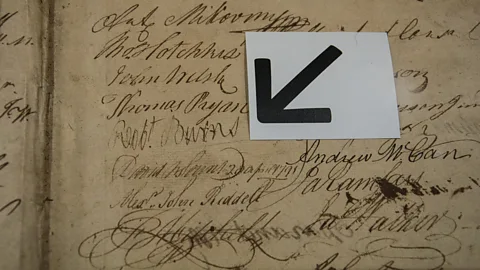 Amanda Ruggeri Amanda Ruggeri
One of the items on display at the Grand Lodge of Scotland’s museum is its membership record with the signature of famed Freemason Robert Burns (Credit: Amanda Ruggeri)
That makes the sheer number of documents to wade through daunting. But it’s also fruitful, like when the Grand Lodge got wind of the Aitchison’s Haven minutes, which were going for auction in London in the late 1970s. Another came more recently when Cooper found the 115-year-old membership roll book of a Scottish Masonic lodge in Nagasaki, Japan.
“There’s an old saying that wherever Scots went in numbers, the first thing they did was build a kirk [church], then they would build a bank, then they would build a pub. And the fourth thing was always a lodge,” Cooper said, chuckling.
 Amanda Ruggeri Amanda Ruggeri
The curator of the Grand Lodge of Scotland, Robert Cooper, looks over the lodge’s museum (Credit: Amanda Ruggeri)
That internationalism was on full display in the Grand Lodge of Scotland’s museum, which is open to the public. It was full of flotsam and jetsam from around the world: a green pennant embroidered with the “District Grand Lodge of Scottish Freemasonry in North China”; some 30 Masonic “jewels” – or, to non-Masons, medals – from Czechoslovakia alone.
Of course, conspiracy theorists find that kind of reach foreboding. Some say Freemasonry is a cult with links to the Illuminati. Others believe it to be a global network that’s had a secret hand in everything from the design of the US dollar bill to the French Revolution. Like most other historians, Cooper shakes his head at this.
“If we’re a secret society, how do you know about us?” he asked. “This is a public building; we’ve got a website, a Facebook page, Twitter. We even advertise things in the press. But we’re still a ‘secret society’ running the world! A real secret society is the Mafia, the Chinese triads. They are real secret societies. They don’t have a public library. They don’t have a museum you can wander into.”
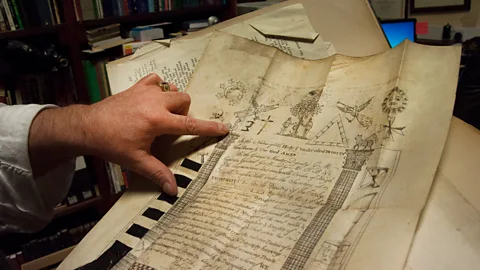 Amanda Ruggeri Amanda Ruggeri
Cooper points to the Masonic symbols on one of the many historic documents in the lodge’s archive (Credit: Amanda Ruggeri)
Some of the mythology about Freemasonry stems from the mystery of its early origins. One fantastical theory goes back to the Knights Templar; after being crushed by King Philip of France in 1307, the story goes, some fled to Argyll in western Scotland, and remade themselves as a new organisation called the Freemasons. (Find out more in our recent story about the Knights Templar).
Others – including Freemasons themselves – trace their lineage back to none other than King Solomon, whose temple, it’s said, was built with a secret knowledge that was transferred from one generation of stonemason to the next.
A more likely story is that Freemasonry’s early origins stem from medieval associations of tradesmen, similar to guilds. “All of these organisations were based on trades,” said Cooper. “At one time, it would have been, ‘Oh, you’re a Freemason – I’m a Free Gardener, he’s a Free Carpenter, he’s a Free Potter’.”
At one time, it would have been, ‘Oh, you’re a Freemason – I’m a Free Gardener, he’s a Free Carpenter, he’s a Free Potter’ – Robert Cooper
For all of the tradesmen, having some sort of organisation was a way not only to make contacts, but also to pass on tricks of the trade – and to keep outsiders out.
But there was a significant difference between the tradesmen. Those who fished or gardened, for example, would usually stay put, working in the same community day in, day out.
Not so with stonemasons. Particularly with the rush to build more and more massive, intricate churches throughout Britain in the Middle Ages, they would be called to specific – often huge – projects, often far from home. They might labour there for months, even years. Thrown into that kind of situation, where you depended on strangers to have the same skills and to get along, how could you be sure everyone knew the trade and could be trusted? By forming an organisation. How could you prove that you were a member of that organisation when you turned up? By creating a code known by insiders only – like a handshake.
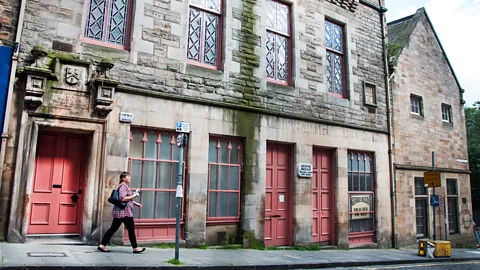 Amanda Ruggeri Amanda Ruggeri
Edinburgh's Lodge of Journeyman Masons No. 8 was founded in 1578; this lodge was built for it on Blackfriars Street in 1870 (Credit: Amanda Ruggeri)
Even if lodges existed earlier, though, the effort to organise the Freemason movement dates back to the late 1500s. A man named William Schaw was the Master of Works for King James VI of Scotland (later also James I of England), which meant he oversaw the construction and maintenance of the monarch’s castles, palaces and other properties. In other words, he oversaw Britain’s stonemasons. And, while they already had traditions, Schaw decided that they needed a more formalised structure – one with by-laws covering everything from how apprenticeships worked to the promise that they would “live charitably together as becomes sworn brethren”.
In 1598, he sent these statutes out to every Scottish lodge in existence. One of his rules? A notary be hired as each lodge’s clerk. Shortly after, lodges began to keep their first minutes.
“It’s because of William Schaw’s influence that things start to spread across the whole country. We can see connections between lodges in different parts of Scotland – talking to each other, communicating in different ways, travelling from one place to another,” Cooper said.
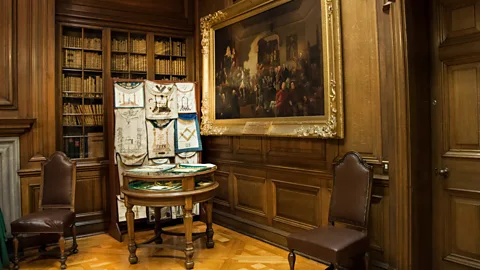 Amanda Ruggeri Amanda Ruggeri
This oil painting at the Grand Lodge of Scotland shows Robert Burns’ inauguration at Lodge Canongate Kilwinning No. 2, which was founded in 1677 (Credit: Amanda Ruggeri)
Scotland’s influence was soon overshadowed. With the founding of England’s Grand Lodge, the English edged out in front of the movement’s development. And in the centuries since, Freemasonry’s Scottish origins have been largely forgotten.
“The fact that England can claim the first move towards national organisation through grand lodges, and that this was copied subsequently by Ireland (c 1725) and Scotland (1736), has led to many English Masonic historians simply taking it for granted that Freemasonry originated in England, which it then gave to the rest of the world,” writes David Stevenson in his book The Origins of Freemasonry.
 Amanda Ruggeri Amanda Ruggeri
Hidden in plain sight on Brodie’s Close off of Edinburgh’s Royal Mile, the Celtic Lodge of Edinburgh and Leith No. 291 was founded in 1821 (Credit: Amanda Ruggeri)
Cooper agrees. “It is in some ways a bit bizarre when you think of the fact that we have written records, and therefore membership details, and all the plethora of stuff that goes with that, for almost 420 years of Scottish history,” he said. “For that to remain untouched as a source – a primary source – of history is really rather odd.”
One way in which most people associate Freemasonry and Scotland, meanwhile, is Rosslyn Chapel, the medieval church resplendent with carvings and sculptures that, in the wake of Dan Brown’s Da Vinci Code, many guides have explained as Masonic. But the building’s links to Masonry are tenuous. Even a chapel handbook published in 1774 makes no mention of any Masonic connections.
 Amanda Ruggeri Amanda Ruggeri
Mary’s Chapel may only be open to fellow Freemasons, but its location is anything but a secret (Credit: Amanda Ruggeri)
Scotland’s true Masonic history, it turns out, is more hidden than the church that Dan Brown made famous. It’s just hidden in plain sight: in the Grand Lodge and museum that opens its doors to visitors; in the archivist eager for more people to look at the organisation’s historical records; and in the lodges themselves, tucked into corners and alleyways throughout Edinburgh and Scotland’s other cities.
Their doors may often be closed to non-members, but their addresses, and existence, are anything but secret.
This story is a part of BBC Britain – a series focused on exploring this extraordinary island, one story at a time. Readers outside of the UK can see every BBC Britain story by heading to the Britain homepage; you also can see our latest stories by following us on Facebook and .
If you liked this story, sign up for the weekly bbc.com features newsletter, called “If You Only Read 6 Things This Week”. A handpicked selection of stories from BBC Future, Earth, Culture, Capital, Travel and Autos, delivered to your inbox every Friday.
https://www.bbc.com/travel/article/20161209-secret-history-of-the-freemasons-in-scotland |
|
|
|
Rispondi |
Messaggio 44 di 56 di questo argomento |
|
11 de agosto de 1943 (miércoles)
[ editar ]
- Al retirarse de la Unión Soviética, Adolf Hitler ordenó la creación del "Muro del Este", una línea de defensa en el lado oriental del Reichskommissariat Ostland , el territorio ocupado por Alemania en Letonia, Lituania y Estonia. [ 25 ]
- Los submarinos alemanes U-468 , U-525 y U-604 se perdieron debido a la acción enemiga en el Océano Atlántico.
- Se estrenó la película de comedia en tecnicolor Heaven Can Wait, protagonizada por Gene Tierney y Don Ameche .
- Nacido:
12 de agosto de 1943 (jueves)
[ editar ]
- Las tropas alemanas evacuaron Sicilia. [ 29 ]
- En un discurso de radio grabado que se transmitió a Filipinas en el aniversario de la ocupación del 12 de agosto de 1898 por los Estados Unidos, el presidente estadounidense Roosevelt dijo que "doy al pueblo filipino mi palabra de que la República de Filipinas se establecerá en el momento en que el poder de nuestros enemigos japoneses sea destruido". Joaquín Elizalde, Comisionado Residente de Filipinas en Washington, dijo a los periodistas que concluyó que Roosevelt quería decir que la independencia llegaría antes de la fecha de independencia programada del 4 de julio de 1946 , aunque eso requeriría una enmienda a la Ley Tydings-McDuffie. [ 33 ] Para cuando se declaró la liberación el 5 de julio de 1945, el tiempo de transición estaría a solo un año de distancia.
- Los combatientes de la resistencia albanesa ejecutaron la emboscada de Kurtës , infligiendo grandes pérdidas a las tropas alemanas.
- El movimiento de resistencia polaco Armia Krajowa (el "Ejército Nacional") llevó a cabo la Operación Góral . En una incursión al mediodía, los hombres de la resistencia tendieron una emboscada a un camión y recuperaron alrededor de 106 millones de zlotys que transportaban en Varsovia las autoridades nazis de ocupación. [ 34 ] La cantidad incautada fue el equivalente en 1943 a 33.000.000 de dólares estadounidenses. [ 35 ]
- La película de terror musical El Fantasma de la Ópera, protagonizada por Nelson Eddy , Susanna Foster y Claude Rains, se estrenó en Los Ángeles.
- Falleció: Bobby Peel , 84 años, jugador de críquet británico
13 de agosto de 1943 (viernes)
[ editar ]
- Después de dos semanas de advertencias a Italia de parte de los aliados de que "el respiro había terminado. El bombardeo de objetivos militares se reanudaría" [ 36 ], los ataques aéreos se reanudaron. La Real Fuerza Aérea británica lanzó toneladas de bombas incendiarias sobre Milán y Turín a primera hora de la mañana, además de realizar el primer bombardeo sobre Berlín desde el 21 de mayo . Poco después de las 11:00 am hora local, los bombarderos estadounidenses comenzaron un ataque aún más duro sobre Roma que el realizado el 19 de julio , y continuaron durante dos horas de bombardeos de precisión sobre los patios ferroviarios de San Lorenzo y Vittorio. [ 37 ] Los bombarderos estadounidenses Liberator atacaron la Austria alemana por primera vez, apuntando a la planta de armas Messerschmitt en Wiener Neustadt al sur de Viena , "demostrando a una Alemania nerviosa por las bombas que prácticamente ningún rincón de su dominio está ahora fuera del alcance de los aviones aliados". [ 38 ]
- El USS John Penn fue torpedeado y hundido por aviones japoneses.
- Falleció: Jakob Gapp , de 46 años, mártir católico romano austríaco, fue ejecutado en la prisión de Plötzensee tras ser declarado culpable de traición al régimen nazi. Recibiría la beatificación el 24 de noviembre de 1996 de manos del Papa Juan Pablo II. [ 39 ]
14 de agosto de 1943 (sábado)
[ editar ]
- Los bombarderos estadounidenses Liberator volaron una distancia récord, recorriendo 2500 millas desde Australia para llevar a cabo el primer bombardeo en la isla de Borneo , atacando las reservas de petróleo japonesas en Balikpapan . [ 40 ]
- Un día después del segundo bombardeo de la capital italiana, Roma fue declarada ciudad abierta por el gobierno italiano, que hizo el anuncio en una emisión de radio de Stetani, la agencia de noticias oficial. El mariscal Pietro Badoglio, el primer ministro italiano , confirmó la decisión más tarde ese mismo día, ofreciendo retirar las defensas de la ciudad, bajo la supervisión de los Aliados, a cambio de que no se produjeran más bombardeos. [ 41 ]
- La batalla de Roosevelt Ridge terminó con victoria aliada.
- La batalla de Belgorod terminó con victoria soviética.
- Se completó la construcción del oleoducto Big Inch , de 2.900 kilómetros de longitud, que abastecía de petróleo directamente desde los yacimientos petrolíferos del este de Texas a los puertos de embarque de la ciudad de Nueva York y Filadelfia. El proyecto había comenzado el 3 de agosto de 1942. [ 42 ]
- El submarino británico Saracen fue dañado por cargas de profundidad de corbetas italianas frente a Bastia , Córcega y hundido para evitar su captura.
- Se estrenó la película de comedia musical This Is the Army, protagonizada por George Murphy , Joan Leslie y Ronald Reagan .
- Nacido: Néstor Cerpa Cartolini , terrorista peruano que lideró el Movimiento Revolucionario Túpac Amaru desde 1985 hasta que fue asesinado en un tiroteo con la policía; en Lima (f. 1997)
15 de agosto de 1943 (domingo)
[ editar ]
- Las tropas estadounidenses y canadienses, preparadas para una fuerte resistencia, invadieron Kiska y se sorprendieron al encontrar la isla desierta. Japón había tomado el control de la isla, parte de Alaska , poco después del ataque de 1941 a Pearl Harbor. [ 43 ] [ 44 ] Aunque no hubo resistencia, cuatro soldados estadounidenses murieron por minas dejadas por los japoneses, y 24 murieron por fuego amigo , "disparados por error por sus propios camaradas en la densa niebla de Kiska". [ 45 ]
- Comenzó la batalla terrestre de Vella Lavella .
- Una unidad polaca del batallón Uderzeniowe Kadrowe llevó a cabo el ataque a Mittenheide .
- Nacimiento: Barbara Bouchet , actriz estadounidense nacida en Alemania, como Barbara Goutscher en Reichenberg , Sudetes, Alemania (ahora Liberec en la República Checa )
16 de agosto de 1943 (lunes)
[ editar ]
- El levantamiento del gueto de Bialystok comenzó poco después de las 10 de la mañana. Las SS alemanas rodearon el gueto judío de la ciudad de Bialystok , en la Polonia ocupada por los alemanes, para iniciar la deportación de miles de residentes a campos de concentración. Cuando comenzó la redada, la fuerza clandestina judía tomó las armas y comenzó a contraatacar. La batalla se prolongó durante cinco días antes de que los alemanes pudieran reprimir la insurrección. La mayoría de los líderes de la revuelta se suicidaron en lugar de ser capturados. [ 46 ]
- Nació: Arlene Render , diplomática estadounidense, en Cleveland
https://en.wikipedia.org/wiki/August_1943 |
|
|
|
Rispondi |
Messaggio 45 di 56 di questo argomento |
|
 
Pope Francis delivered a speech too progressive for Obama to give
Sep 24, 2015, 4:20 PM GMT-3
Pope Francis waves to the crowd from the Speakers Balcony at the US Capitol, September 24, 2015, in Washington, DC. Pool/Getty Images
If President Barack Obama had delivered the text of Pope Francis’s speech to Congress Thursday as a State of the Union address, he would have risked being denounced by Republicans as a socialist.
While most Republicans chose not to complain, and Democrats tried not to gloat, Francis’s speech to Congress was stunning in the breadth, depth, and conviction of its progressivism. That might not have been fully and immediately appreciated by everyone in the House chamber because the combination of Francis’s sotto voce delivery and his heavily accented English made it difficult, lawmakers said, to grasp everything he was saying.
But there was no mistaking his thrust. He made detailed arguments for openness to immigrants, addressing the human roots of climate change, closing the gap between the rich and the poor, and ending the death penalty — all of which invigorated the Democrats in the room.
“It was pretty progressive. He had a little right-to-life stuff in it,” Rep. James Clyburn, the third-ranking House Democrat, said as he cracked a smile thinking about how Republicans would receive the speech. “That’s enough for them.”
The pope isn’t going to change many hearts and minds in the badly divided Congress, lawmakers said, but the moment provided a brief respite from political warfare. Several presidential candidates, including Sens. Bernie Sanders, Lindsey Graham, Marco Rubio, and Ted Cruz, as well as Ben Carson, attended.
Rubio, a Roman Catholic, said in a brief interview that Francis “struck the right tone.” Sanders, a self-described socialist, seemed to like the content even more.
“Pope Francis is clearly one of the important religious and moral leaders not only in the world today but in modern history,” he said in a statement released after the speech. “He forces us to address some of the major issues facing humanity: war, income and wealth inequality, poverty, unemployment, greed, the death penalty and other issues that too many prefer to ignore.”
Democrats were eager enough to present Congress as united that they joined a Republican-led standing ovation when Francis told lawmakers of “our responsibility to protect and defend human life at every state of its development.” Several of them said it was out of respect for the pope. But there was another good reason: It strengthened the perception that the whole speech — most of which they liked — carried unifying themes.
Unity was good for Democrats because the speech favored their policies
Francis was interrupted a few times by whoops from the Democratic side of the chamber — by Steve Cohen, a Jewish Memphis Democrat who got excited about Francis’s mention of the Golden Rule; by New York’s Nydia Velázquez when he called for an end to the death penalty; and by Philadelphia Rep. Chaka Fattah when he mentioned his upcoming visit to that city. The Republicans in the room were a bit more staid. Cruz often appeared unmoved during moments when Rubio, who was sitting nearby, applauded. That was the case when Francis asked whether the greater opportunities sought by past generations of immigrants are “not what we want for our own children?”
It was a home crowd. Rep. Paul Gosar (R-AZ) had announced he would boycott the event over climate change, and there was a brief murmur when it became obvious that three conservative Catholic Supreme Court justices — Antonin Scalia, Samuel Alito, and Clarence Thomas — had not shown up. But it seemed that everyone in attendance just wanted to catch a glimpse of Francis and hear what he had to say.
Big-name guests filed into the public galleries above the House chamber long before the pope’s arrival: Former House Speaker Newt Gingrich, former Rep. Gabby Giffords, mega-donor Tom Steyer, and Carson. House members filled the seats in their chamber, followed by the Senate and four Supreme Court justices. At about a minute past 10 am, Francis strode down the center aisle of the House chamber, clad in his familiar white robe and skullcap.
Lawmakers, who had been admonished not to touch the pope, refrained from trying to shake his hand or pat his back. There was no rush to crowd him the way members of Congress try to get into pictures with the president during the annual State of the Union address. When he got to the end of the aisle, he quietly shook hands with Secretary of State John Kerry and then made his way to the rostrum.
Samantha Power, the US ambassador to the UN, pulled out a baby blue iPhone and began snapping pictures. Though she later took to Twitter to commemorate the moment, Power hadn’t posted any of her photos by midday.
For his part, Francis warmed up the audience by describing America as “the land of the free and the home of the brave.” He was slow to move into more politically charged territory but unimpeded when he did. There were 10 standing ovations after his initial greeting, and they were bipartisan.
Francis tackled tough issues at the heart of the US political debate and gently admonished lawmakers to build bridges
At times, Francis seemed to be speaking directly into the headlines and newscasts of the day.
Less than a week after Carson said that America shouldn’t elect a Muslim president, Francis warned that “a delicate balance is required to combat violence perpetrated in the name of a religion, an ideology or an economic system, while also safeguarding religious freedom, intellectual freedom and individual freedoms.”
As Republican presidential frontrunner Donald Trump promises to build a wall between Mexico and the US, and to prevent Syrian refugees from being admitted to America, Francis compared the current refugee crisis to the one that arose in World War II and said that “we the people of this continent are not fearful of foreigners, because most of us were once foreigners.” That drew a standing ovation. Rubio, who has shifted his emphasis on immigration reform over time, leaped to his feet.
And while Democrats continue to bask in this summer’s Supreme Court decision protecting same-sex marriage, the pope said he was concerned that “fundamental relationships are being called into question, as is the very basis of marriage and the family.” The issue that caused the biggest stir before the speech — climate change — factored prominently in Francis’s remarks. He spoke of the human roots of global warming and said, “I am convinced we can make a difference.”
But perhaps the most unexpected run in the speech was an admonishment as gentle as it was clear: Politics is about building bridges, not destroying them. Francis never mentioned the international nuclear nonproliferation deal with Iran by name or the gridlock in American politics, but he seemed to be speak to both matters.
“When countries which have been at odds resume the path of dialogue — a dialogue which may have been interrupted for the most legitimate of reasons — new opportunities open up for all,” he said. “A good political leader is one who, with the interests of all in mind, seizes the moment in a spirit of openness and pragmatism. A good political leader always opts to initiate processes rather than possessing spaces.”
Pennsylvania Republican Rep. Joe Pitts, speaking about the pope’s limited remarks on abortion and same-sex marriage, said he was displeased that Francis had been “unfortunately politically correct.”
For liberals, though, he was simply correct about politics.
https://www.vox.com/2015/9/24/9393731/pope-francis-speech-progressive-obama
|
|
|
|
Rispondi |
Messaggio 46 di 56 di questo argomento |
|
|
|
|
Rispondi |
Messaggio 47 di 56 di questo argomento |
|
|
|
|
Rispondi |
Messaggio 48 di 56 di questo argomento |
|
Evidence the Knights Templar got to America!

The latest episode of Templar Knight TV looks at claims the Knights Templar got to America. It’s alleged they managed to do this a hundred years before Christopher Columbus reached the New World. But is there any truth to this?
The story starts with the Templars’ demise. It’s 1307 and they are being rounded up, imprisoned and some are burned to death. Little wonder some Knights Templar may have fled. A popular theory runs that when word got out that they were doomed, some knights transported treasure from the Paris Temple to the port of La Rochelle. From there, ships took the surviving Templars to Scotland. And then what happened?
Well, I was involved in a programme last year called America Unearthed presented by Scott Wolter. He is a forensic geologist and his analysis of rock carvings in the United States and Scotland has convinced him the knights made the long journey. With the help of a Scottish aristocrat called Henry Sinclair, they crossed the Atlantic to Nova Scotia.
As you will all know, proof that the Knights Templar got to America is offered in the form of items found at Oak Island in Nova Scotia; an enigmatic tower at Newport, Rhode Island and what is claimed to be the engraving of a knight in Westford, Massachusetts. But sceptics abound. They’re not convinced by the Money Pit at Oak Island, think the Newport Tower is a 17th century windmill and that the Westford Knight is a trick of the eye on a glacial boulder.
FIND OUT MORE: Did the Knights Templar take the Holy Grail to America?
As for the Sinclair connection, sceptics point out that these Scottish nobles testified against the Templars at their trial. Far from being good friends and allies of the knights, they had little sympathy and turned on them in their hour of need.
DISCOVER: The Westford Knight is disappearing!
Nevertheless, the argument rages on that the Knights Templar got to America. I go to Rosslyn chapel where some have pointed to images that look like maize – a crop that didn’t exist in the Old World before Columbus. And in the basement sacristy, lines on the wall are claimed to be a map. I had exclusive access when the chapel was empty to film for myself and you can see what I found.
I do hope you can spare a quarter of an hour to get your weekly Templar dose!
https://thetemplarknight.com/2020/09/15/knights-templar-america/ |
|
|
|
Rispondi |
Messaggio 49 di 56 di questo argomento |
|
|
|
|
Rispondi |
Messaggio 50 di 56 di questo argomento |
|
|
|
|
Rispondi |
Messaggio 51 di 56 di questo argomento |
|
|
|
|
Rispondi |
Messaggio 52 di 56 di questo argomento |
|
|
Our 26th President Teddy Roosevelt was a Freemason.
He is Honored with a Memorial in Washington D.C. on an Island in the Potomac River. The Island was once called "MY LORDS ISLAND" and was known as "MASON ISLAND".
An interesting alignment occurs when a map of Washington DC is viewed looking to the EAST...
Place two diagrams of the Great Pyramid (with slopes of 51.51) on the map of DC with their corners touching and resting on the Roosevelt Memorial on "MASON ISLAND" --- |
|
|
|
Rispondi |
Messaggio 53 di 56 di questo argomento |
|
|
|
|
Rispondi |
Messaggio 54 di 56 di questo argomento |
|
|
|
|
Rispondi |
Messaggio 55 di 56 di questo argomento |
|
El pentagrama es una firma geométrica de Venus, lo que tiene mucho sentido en el contexto actual.
On June 5-6, 2012, a transit of Venus occurred, where Venus appeared as a small, dark spot passing across the face of the sun. This rare astronomical event happens in pairs, eight years apart, and is separated by 105 or 121 years. The transit began at 22:09 UTC on June 5, 2012, and ended at 04:49 UTC on June 6, 2012. The exact times varied by up to ±7 minutes depending on the observer's location.
|
|
|
|
Rispondi |
Messaggio 56 di 56 di questo argomento |
|
|
|
 Primo Primo
 Precedente
42 a 56 de 56
Successivo Precedente
42 a 56 de 56
Successivo
 Ultimo
Ultimo

|
|
| |
|
|
©2025 - Gabitos - Tutti i diritti riservati | |
|
|

